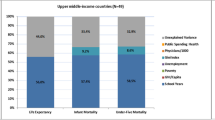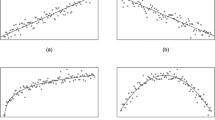Abstract
Objectives
Relationship between human resources for health and mortality remains inconclusive despite numerous studies published on the topic in the last decades. This paper investigates how and why methodological trade-offs implicitly made by researchers when using macro-data can in part explains this puzzling lack of agreement.
Methods
Using data from the Global Health Observatory, we build a model of the relationship between human resources and mortality, which we progressively alter by changing its scope, variables and analysis period. Then, we compare results among themselves to isolate the impact of methodological choices from other changes in the data.
Results
Results demonstrate how methodological choices linked to (1) the analysis period, (2) the definition of health inputs, health outcomes and control variables and (3) the choice of specific variables as proxy for human resources and health outcomes affects the relationship between human resources and health outputs.
Conclusions
Results presented highlights the need for complementing existing macro-analysis with other analytical strategies, for better documenting methodological choices in research studies, as well as for further supporting countries’ efforts to produce reliable and consistent data.

Similar content being viewed by others
References
Adams P, Hurd M, McFadden D, Merril A, Ribeiro T (2003) Healthy, Wealthy, and Wise? Test for Direct Causal Paths between Health and Socioeconomic Status. J Econom 112:3–56
Anand S, Bärnighausen T (2004) Human resources and health outcomes: cross-country econometric study. Lancet 364:1603–1609
Anand S, Bärnighausen T (2007) Health workers and vaccination coverage in developing countries: an econometric analysis. Lancet 369:1277–1285
Ananthakrishnan AN, Hoffmann RG, Saeian K (2010) Higher physician density is associated with lower incidence of late-stage colorectal cancer. J Gen Intern Med 25(11):1164–1171
Bhargava A, Chowdhury S, Singh KK (2005) Healthcare infrastructure, contraceptive use and infant mortality in Uttar Pradesh, India. Econ Hum Biol 3:388–404
Bloom DE, Canning D (2000) The health and wealth of nations. Science 287:1207–1209
Bryce J, el Arifeen S, Pariyo G, Lanata CF, Gwatkin D, Habicht JP (2003) Reducing child mortality: can public health deliver? Lancet 362(9378):159–164
Case A, Lubotsky D, Paxson C (2002) Economic status and health in childhood: the origins of the gradient. Am Econ Rev 92(5):1308–1334
Castillo-Laborde C (2011) Human resources for health and burden of disease: an econometric approach. Hum Resour Health 9:4
Croppenstedt A, Muller C (2000) The Impact of Farmer’s Health and Nutritional Status on Their Productivity and Efficiency: Evidence from Ethiopia. Ec Devel Cult Change 48(3):475–502
Cutler D, Deaton A, Lleras-Muney A (2006) The determinants of mortality. The J Econ Perspect 20(3):97–120
Deaton A (2002) Policy implications of the gradient of health and wealth. Health Aff 21(2):13–30
Deolalikar AB (1988) Nutrition and Labor Producvivity in Agriculture: Estimates for Rural South India. Rev Econ Stats 70(3): 406–414
Dickson KE, Simen-Kapeu A, Kinney MV, Huicho L, Vesel L, Lackritz E, de Johnson Graft J, von Xylander S, Rafique N, Sylla M, Mwansambo C, Daelmans B, Lawn JE (2014) Every Newborn: health-systems bottlenecks and strategies to accelerate scale-up in countries. Lancet 384:438–454
Dillon A, Friedman J, Serneels P (2012) Experimental estimates of the impact of malaria treatment on agricultural worker productivity, labor supply and earnings. International Bureau of Labor Affairs
Easterlin RA (2013) Cross-Sections Are History. Popul Dev Rev 38:302–308
Farahani M, Subramanian SV, Canning D (2009) The effect of changes in health sector resources on infant mortality in the short-run and the long-run: a longitudinal econometric analysis. Soc Sci Med 68(11):1918–1925
Franks P, Fiscella K (1998) Primary care physicians and specialists as personal physicians. Health care expenditures and mortality experience. J Fam Pract 47(2):105–109
Grossman M (1972) On the concept of health capital and the demand for health. J Political Econ 80(2):223–255
Grossman M (2000) The human capital model. In: Culyer AJ, Newhouse JP (eds) Handbook of health economics, vol 1. Elsevier, Amsterdam
Gulliford MC (2002) Availability of primary care doctors and population health in England: is there an association? J Public Health Med 24(4):252–254
Hertz E, Hebert JR, Landon J (1994) Social and environmental factors and life expectancy, infant mortality, and maternal mortality rates: results of a cross-national comparison. Soc Sci Med 39:105–114
Hsiao C (2007) Panel data analysis: advantages and challenges. TEST 16(1):1–22
James WL, Cossman JS (2006) Does Regional Variation Affect Ecological Mortality Research? An Examination of Mortality, Income Inequality and Health Infrastructure in the Mississippi Delta. Popul Res Policy Rev 25:175–195
Michaud PC, van Soest A (2008) Health and wealth of elderly couples: Causality tests using dynamic panel data models. J Health Econ 27(5):1312–1325
Pritchett L, Summers LH (1996) Wealthier is healthier. J Hum Resour 31(4):841–868
Ricketts TC, Holmes GM (2007) Mortality and physician supply: does region hold the key to the paradox? Health Serv Res 42(6 Pt 1):2233–2251 (discussion 2294–323)
Rivera B, Currais L (2005) Individual Returns to Health in Brazil. In: López-Casasnovas G, Rivera B, Currais L (eds) Health and Economic Growth: Findings and Policy Implications. MIT Press, Cambridge
Robinson J, Wharrad H (2001) The relationship between attendance at birth and maternal mortality rates: an exploration of United Nations’ data sets including the ratios of physicians and nurses to population, GNP per capita and female literacy. J Adv Nurs 34:445–455
Schultz TP (2002) Wage Gains Associated with Height as a Form of Health Human Capital. Am Econ Rev 92(2):349–353
Schultz TP (2005) Productive Benefits of Health: Evidence from Low-Income Countries. Economic Growth Center Discussion Paper Nº 903
Schultz TP, Tansel A (1997) Wage and Labor Supply Effects of Illness in Côte d’Ivore and Ghana: Instrumental Variable Estimates for Days Disabled. J Dev Econ 53(2):251–286
Speybroeck N, Kinfu Y, Dal Poz MR, Evans DB (2006) Reassessing the relationship between human resources for health, intervention coverage and health outcomes. Background paper prepared for The World Health Report 2006
Starfield B, Shi L, Grover A, Macinko J (2005) The effects of specialist supply on populations’ health: assessing the evidence. Health Aff 24: W5–97
Strauss J (1986) Does Better Nutrition Raise Farm Productivity? J Polit Econ 94(2):297–320
Thomas D, Strauss J (1997). Health, Wealth, and Wages: Evidence on Men and Women in Brazil. J Econom 77(1):159–185
Thomas D, Frankenberg E, Friedman J, Habicht JP, Hakimi M, Ingwersen N, Jasgawi, Jones N, McKelvey C, Pelto G, Sikoki B, Seeman T, Smith JP, Sumantri C, Suriastini W, Wilope S (2006). Causal effect of health on labor market outcomes: Experimental evidence. California Center for Population Research 070–06
van den Berg GJ, Lindeboom M, Portrait F (2006) Economic conditions early in life and individual mortality. Am Econ Rev 96(1):290–302
Vogel RL, Ackermann RJ (1998) Is primary care physician supply correlated with health outcomes? Int J Health Serv 28(1):183–196
Watson DE, McGrail KM (2009) More doctors or better care? Healthc Q 12(4):101–104
Weil DN (2007) Accounting for the effect of health on economic growth. Q J Econ 122(3):1265–1306
Acknowledgements
We thank the 2015 class of “Concepts and Methods in Global health” at Harvard T.H. Chan School of Public Health, led by Till Bärnighausen and Barry Bloom for their constructive feedback throughout the class, as well as Chris Wheelahan, and two anonymous reviewers for their careful reading of the manuscript.
Author information
Authors and Affiliations
Corresponding author
Ethics declarations
No funding was received for this study.
This article does not contain any studies with human participants or animals performed by any of the authors. No ethical approval was obtained for this study, as it uses publically available data.
Electronic supplementary material
Below is the link to the electronic supplementary material.
Rights and permissions
About this article
Cite this article
Villalobos Dintrans, P., Chaumont, C. Examining the relationship between human resources and mortality: the effects of methodological choices. Int J Public Health 62, 361–370 (2017). https://doi.org/10.1007/s00038-016-0935-4
Received:
Revised:
Accepted:
Published:
Issue Date:
DOI: https://doi.org/10.1007/s00038-016-0935-4




